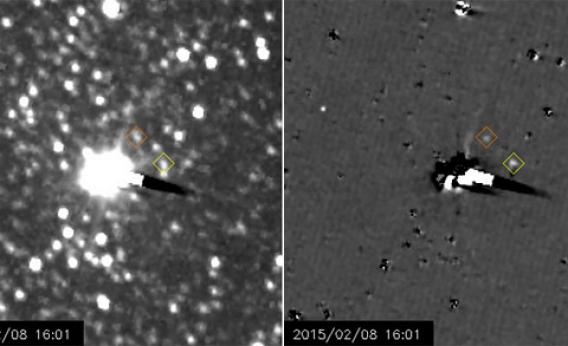Create a free profile to get unlimited access to exclusive videos, sweepstakes, and more!
Mooning Pluto

Pluto is an interesting little world. Smaller than our Moon, it still boasts no fewer than five moons discovered so far. The first, Charon, was discovered in 1978, but the second through fifth were found just a few years ago using Hubble data.
How many does Pluto have? It’s not known, because smaller, fainter moons may yet be undiscovered. But as the New Horizons probe nears Pluto, we may find more.
Charon is big and relatively bright and has been seen in New Horizons images since 2013. But now two of the smaller moons, Nix and Hydra, have been spotted as well!
The animation on the left shows Pluto heavily overexposed (the bright tail off to the right is called blooming, and it’s an artifact of some digital detectors), with stars in the background. The moons have boxes around them to make them easier to spot. The animation on the right has the stars subtracted off, making it easier to see the moons’ orbital motions around their parent body. To give you a sense of scale, Nix and Hydra orbit about 50,000 and 65,000 kilometers out from Pluto. The moon’s physical sizes are unknown, though less than 100 km across. They’re unresolved in these images, and in the Hubble images as well. When New Horizons gets closer it will certainly give us a far better idea about these little guys.
Each frame of each animation is a total of a 50 second exposure, which is pretty impressive. New Horizons is moving pretty fast, about 14 km/sec, so it needs to take short exposures as it flies through the Pluto system or else there will be motion blur.
These images are mere tastes of what’s to come. In the months ahead we’ll see Pluto resolved, surface features revealing themselves, and more detail on these moons as well. Perhaps the probe will discover more moons circling Pluto, too.
Hopefully it will shed light on how the moons formed; one current theory is that Pluto and Charon formed at the same time, out of the material that formed all the icy bodies past Neptune. Then, later, an impact on Pluto blasted chunks into space, which formed the other moons. Pluto doesn’t have a lot of gravity, but it also lacks nearby neighbors, so it can hold on to several moons without losing them due to perturbations from other massive bodies. We know many asteroids and other big icy objects past Neptune have moons, so seeing these close up may be able to help us understand how they came to be in the first place.














